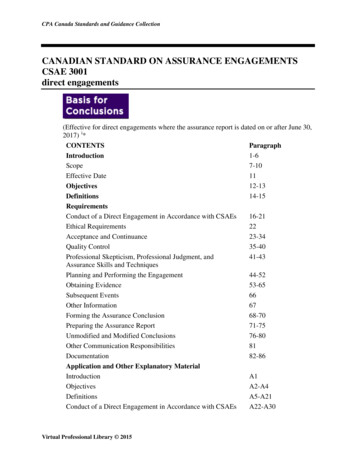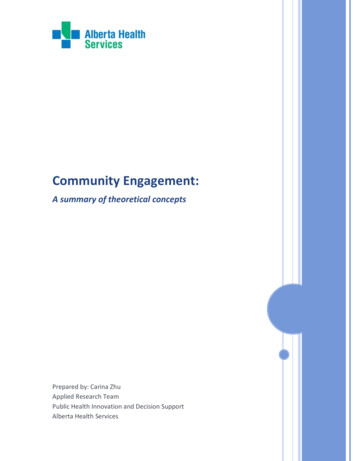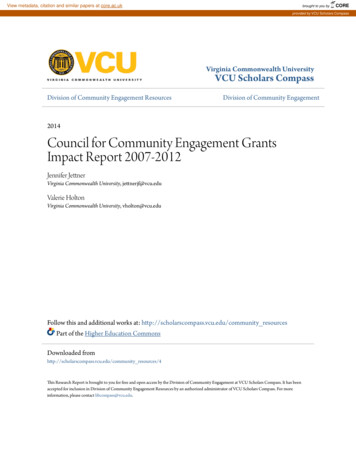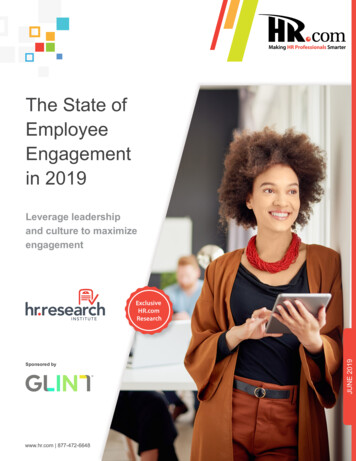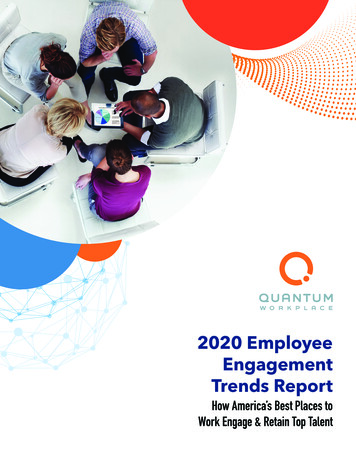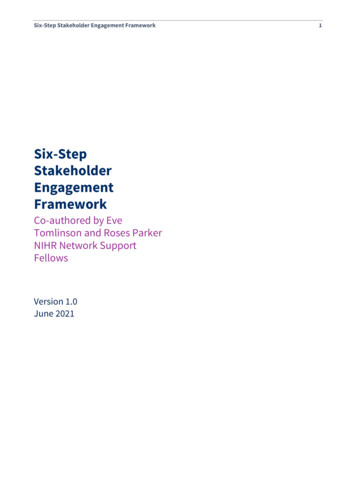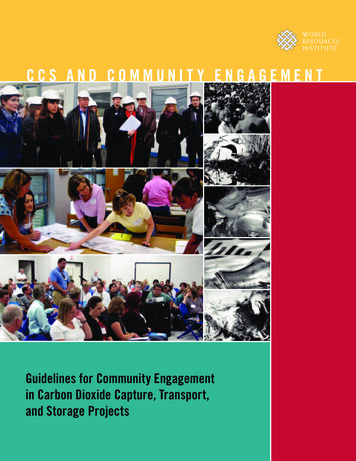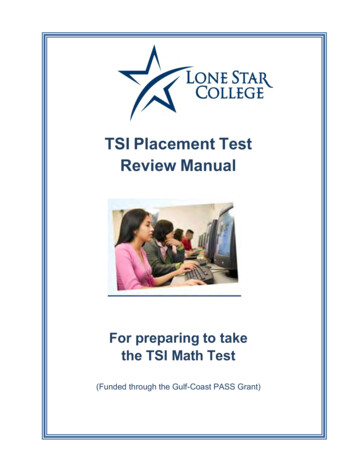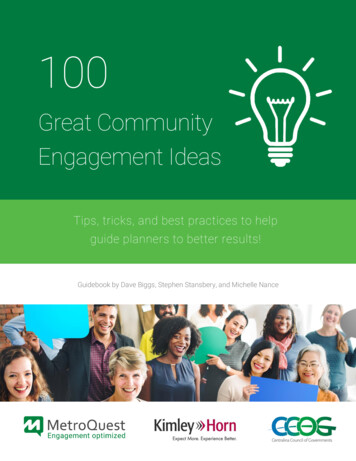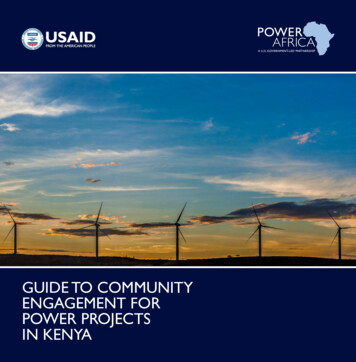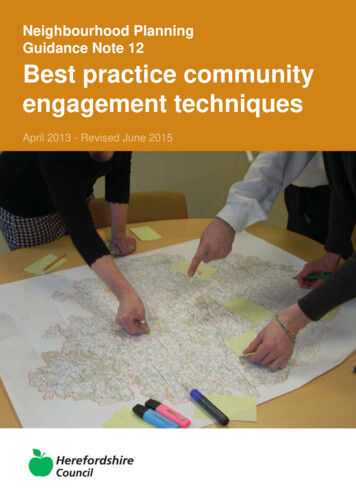
Transcription
Neighbourhood PlanningGuidance Note 12Best practice communityengagement techniquesApril 2013 - Revised June 2015
Community engagement is the active participation of local residents and community groupsin the decisions that affect their lives. This guidance note explains the benefits and principlesfor effective community communication, plus a range of consultation methods that can beused for engagement.This document is copyright of Herefordshire Council, please contact the Neighbourhood Planningteam if you wish to reuse it in whole or part.
IntroductionFor the purpose of this guidance it is important tooutline an understanding of the terms ‘community’and ‘engagement’.be to find solutions and help manage theirexpectations. It also helps your community tounderstand the neighbourhood planningprocess and the progress of your plan. Satisfaction – it increases the satisfaction with Community refers to a group of people thatshare a common place (for example, yourvillage, your parish(es) or within yourNeighbourhood Area); a common interest (forexample, an interest in the environment, sportand health and social care); or a commonidentity (normally demographic characteristicsfor example, age). There are also individualsand groups with common needs. Engagement refers to a range of interactionswhich are suitable for all parties involved. Itcould range from simple information givingthrough to supporting community activity. Asappendix 1 shows, it spans a range of activities.Benefits of community engagementWell run community engagement will bringextensive benefits to the progression of yourNeighbourhood Development Plan and willencourage the involvement of local residents,groups, businesses, developers and a number ofagencies. Benefits of meaningful, two waycommunity engagement include: Trust – it builds trust between the parishcouncil(s), local people, developers and serviceproviders. Opportunity to influence – it gives local peopleand communities the opportunity to influencedecisions that will affect them. Knowledge of local issues - it taps into localknowledge and expertise and makes sure yourNeighbourhood Plan is as well informed aspossible by the people who know its problemsbest; your local inhabitants. Removing barriers – it removes physical,language or social barriers to communitiesgetting access to information or voicing needsor opinions.the progress of the plan and the community’sability to shape that future environment. A sense of ownership – it supports communityspirit and encourages the local people to takecontrol of their own neighbourhoods, which willincrease the chances of a successful outcome.However, some people involved in communityengagement have highlighted potentialdrawbacks. For example, well runcommunity engagement can be very resourceintensive in both time and money. It can alsobe difficult to manage the different views of therespondents.Importance of recording yourcommunity engagementConsultation will form a very important part ofyour Neighbourhood Development Plan. Yourplan should be a community led document andgreater community involvement will assist theprogress of your plan through the process andimportantly the referendum.A consultation statement will be required as partof the submission of your NeighbourhoodDevelopment Plan. The statement will need tooutline the range of consultations which havebeen undertaken and how the development ofyour plan has responded to the commentsreceived. Separate guidance is available entitled‘Writing a consultation statement’ - guidance note14.10 Principles for effectivecommunity engagementThe following principles for effective communityengagement provide a useful starting point formaking your consultation event work. The engagement is effectively designed so thatit will make a difference. Community understanding – it enableseveryone to know about and understand howcomplex some of the local issues may be. Thiswill help people understand how difficult it can Encourage and enable everyone affected to beinvolved.Best practice community engagementtechniques
Plan its delivery in a timely and appropriateway. Work with relevant partner organisations. Information should be jargon free, appropriateand understandable. Make it easier for people to take part. Enable people to take part effectively.considerable demands on both the organisersand the participants. Many people within yourarea will have busy lives which makesattendance at meetings difficult. Consider thetiming of consultations to ensure the widest rangeof people can be involved. Identify opportunitiesto connect with other events within the area; thiswill save resources and time on your part andensure you reach a wider audience.Appropriate communicationtechniques Engagement is given the right resources &support to be effective. People are told the impact of their contribution Reflect on past experiences to improve yournext round of consultation and engagement.Good community engagement can help createindividuals that are active and engaged and whoare resourceful, gifted and creative. Likewise,good community engagement can help parishesto be seen by their community as readily andenthusiastically responding to their localcommunities’ desire for involvement andcollaboration.Reaching all sectors of thecommunityNeighbourhood planning should be fullyinclusive within the community. Everyone shouldbe given an equal right to have their views heardand respected. Good community engagementcan build new relationships and links, andreinforce existing ones. Therefore, some thoughtshould be given to the best way to reach widergroups and remove barriers to those who aretraditionally under-represented in your parishissues and meetings. This will include those withdiffering views and those who often do not gettheir voices heard such as younger people,people living in remote rural areas or thosewhose first language may not be English.Do not just contact those people who you knowor who you think will agree with your views. Makesure that the whole community is aware of yourintention to develop a NeighbourhoodDevelopment Plan.Communication techniques can be divided intothe direct and indirect. Direct method meansface-to-face, letters, email or telephoneconversations with individuals. Indirect methodscould include leaflets, advertising, radioprogrammes, articles in newspapers and pressreports. These are indirect because they do notinvolve any direct contact between the persongiving the message and the person receiving it.The influence of indirect communications isalways harder to quantify and may rest as muchin a change of general ‘atmosphere’ as in itsspecific influence on individuals.Some members of the community may feelapprehensive about being involved in large publicmeetings and expressing their views in a publicarena, especially if they do not have a great dealof experience in that style of meeting.‘Open Space’ meetings would allow theparticipants to create their own agenda anddiscussions in a less formal setting than a publicmeeting. Essentially people write down orsuggest issues at the start of the meeting andthen form smaller groups with people of similarconcerns, to talk about the opportunities and wayforward. Participants are given the opportunity tomove between discussion groups and take part inas many or as few as they feel comfortable with.To organise an open space meeting you need to: Send an open invitation to your community, thatexplains the purpose of the meeting Arrange the meeting chairs into a circle Provide a bulletin board or graffiti wall forEnsure that you are realistic about how and whenyou can engage people. Consultations makeparticipants to raise issues and offersuggestionsBest practice community engagementtechniques
Provide breakout spaces where participantsThe outcomes from the meeting can then becollated and fed back to the whole group.proposals, or understanding what people thinkabout facilities or services. They can be used togather information from a large number of people.They are also useful for establishing informationthat can be re-tested to see if results change overtime.See appendix 2, a community technique methodmatrix, which will help you think about variousconsultation methods, and determine which oneis the best method to use at each stage whenproducing your plan.Designing a questionnaire can be challengingand time-consuming. Questions need to beframed in a manner which is easily understood,covers all possible options and avoids “leading”the respondent.It is essential that the content of yourNeighbourhood Development Plan represents theviews of the wider community, not just those ofthe project group. In developing your plan thereshould be a two-way flow of information betweenthe project group and the wider community.To assist you with this process see GuidanceNote 29 Creating a questionnaire. Once you havedrafted your questionnaire it is a good idea to testit on others before you make it public.can move freely between discussion/topicgroupsA range of consultation methods that could beused are highlighted below:The Neighbourhood Planning team will also beable to give feedback on your drafts.Consider the following when designing aquestionnaire: Public meetings - A public meeting is opento all, offering an opportunity for people to raiseissues and ask questions, and be givenanswers that can be heard by others in the room.Public meetings are a good way to float ideasand explore possible proposals before they areformalised. A good experience of a meeting canencourage people to become more involved in anengagement process. It can be an excellent wayto communicate with large numbers of people ,however they can be dominated by outspokenindividuals and not everyone is comfortablespeaking in public. Information required and how it will be used; Target participants; Questions; Test to ensure effectiveness; Delivery method(s); Collation, analysis and publication of results; Thanks and feedback to respondents. Roadshows and public exhibitions - Usethe idea that ‘a picture is worth a thousand words’to convey information. These can be combinedwith other events and taken out to where peoplealready are, such as school events or summerfayres. This reduces the need to attract people tospecific events. They can appeal to groups, suchas young people, who may not respond todocument or meeting-based methods. Exhibitionscan be used to gather immediate reactions fromthose who attend. Surveys and questionnaires - The singlemost widely used engagement method. Used tocollect quantitative answers from which, if theparticipants are representative, wider publicopinion can be deduced. They can also be veryuseful for gauging public reactions to ideas and Local Workshops - Designed to enablepeople to work actively and collaboratively onan issue or task. Although, they may begin withbackground briefings or presentations, but theyare not about providing information or askingquestions. Workshops usually run for at least halfa day. Workshops can encourage joint workingand problem solving, and help to build a sense ofownership of the results. Newsletters/parish magazines - Oneof the cheapest and most effective methods ofkeeping people informed. Using a newsletter orparish magazine in isolation, however, should notbe regarded as engagement. They are a usefulcomplement to other forms of engagement, andcan be a good way to signpost meetings orBest practice community engagementtechniques
workshops and report the results of suchmethods. Newsletters should be kept short andsharp and the style should be lively. It is a goodidea to feature pictures of key people, with theiragreement, to make them seem less faceless,include photos taken at any consultation events. Open days and drop in sessions - A wayof reaching out to the community and seekinginformal contact especially if you piggy-back ontoexisting local events or venues, such as fetes,markets, redundant shops etc. They can be usedto publicise later engagement and can fit intopeoples personal timetables. Participants can begiven additional information to take away withthem. They give people the opportunity to makepersonal contacts and have individual questionsanswered. Web-based processes - In the last fewyears’ web-based engagement processes havebegun to be more widely used i.e. parish councilwebsites, Facebook, Twitter, NeighbourhoodPlanning specific website. They offer a number ofadvantages: people can participate withouthaving to travel to meetings, it saves paper,enables people to focus on the issues thatparticularly interest them, and work well forpeople who feel intimidated by speaking in public.Online methods can be used as stand-aloneprocesses or in parallel to or integrated withoffline engagement methods. Consultation documents - A well writtendocument allows the consulters to set out indetail the whole of a situation and ask specificquestions. A document can be used to explaincomplexity and provide background information.Document-based consultation is safe andpredictable, and avoids some of the risks offace-to-face processes. Web-based processesallow comments on documents and responses toquestions to be displayed in full. The web-basedprocess enables participants to navigate directlyto the parts of the document that interest them.other methods because they are not comfortablewith writing or because of other constraints. Interviews - Can involve intensive, face-toface meetings, telephone conversations or streetcorner encounters. This is a good way to obtaininformation from an individual. It’s relativeinformality and spontaneity can help to uncoverissues and ideas which can then be fed into moreformal large-scale consultations. Questions canbe asked to get a sense of the local context,particular issues and the sort of engagementmethods that might be most appropriate. Planning for Real - Is an eye catching,hands-on method which is used to sort out whatneeds to be done to improve yourneighbourhood. It involves a large 3D model orlarge scale map of the community. The model isused at open meetings to suit the needs of thecommunity. Participants place suggestions forthe community on cards or flags which are thenplaced at appropriate points on the model.Benefits of this method are: it’s visual impact, itsinformality, participants can contributeanonymously and all ages can contribute. Place checks/Reconnaissance trips Place audits involve a group of local people ina direct inspection of their Neighbourhood Area.Reconnaissance trips are the same but involvemixed teams of local people and technicalexperts. They are used to familiarise everyonewith the physical environment and key issues inthe area and to review progress at intervals.A route is carefully planned to include key localfeatures and issues. The route may be walkedor use buses or other forms of transport. It mayinclude visits to buildings or facilities.Usually a team leader will direct the group anddetermine the pace. The group make notes,sketches, take photos and talk informally topeople in their own setting. Citizens’ panels - Panels of local people are Focus groups - Groups of 6-12 peoplecarefully selected to be representative of adesignated part of the population. Focus groupsare qualitative processes which are good fordeepening the understanding of how people thinkand feel about issues. The advantage of thismethod is members can be carefully recruited tofit specific roles. Focus groups can obtainopinions from people who would not respond toconvened to allow regular testing of their opinionon local issues. They overcome the problem ofhaving to recruit for each separate exercise. Thecomposition of panels can be maderepresentative of the population whose views arerequired i.e. your community. The response ratefrom panels is usually high, and the panels canalso be used to disseminate information.Best practice community engagementtechniques
Community fairs - Provide a fun occasionthat will draw a crowd of all ages andbackgrounds. It then provides an opportunity toinform and engage the people within acommunity at one event. They can createinterest from media groups and lead to increasedcoverage of the issue. The main value ofcommunity fairs is for organisations who wantto show a different face to the public, such asthe police. Community fairs tend to work best ifa number of organisations in the community gettogether to run them. Leaflets and posters - An effective methodof publicising or conveying simple messagesregarding a larger consultation or one of themethods already highlighted.Consultation Do’s and Dont’s Do have a plan; don’t rely on ad hocmeetings; Do draft your consultation strategy early; Do allow everyone to have their say and feelbe involved in the process by sharingconsultation responses and views with them.Remember to review the method you have usedand reflect on which elements worked well andwhere there are gaps. Are there any sections ofthe community who did not engage and werethere reasons why. Share your experiences withother parishes and help build a sharedknowledge of techniques and good practice.Useful community engagement webresourcesEden Project: How to plan your /Developing your comprehensive communityengagement nvolving People: A practical de.pdfinvolved; Do think how it is best to reach everyone withinyour community including those who live andwork in the area and local landowners;Participation Cymru: National Principles for PublicEngagement and other information andresources, including nalprinciples Do refine; amend; test the questions; Do invite others to offer advice; for examplethird parties/stakeholders; Do have a method for collecting, collating anddisplaying all responses transparently; Do have a method for acknowledgingresponses and telling people how theirresponses have been acted upon; Do keep excellent records; Don’t just talk to those who are friendly or whoshare your views; Don’t get into arguments on the substance.Review consultation successesConsultation within your community should not bea one-off event. Ensure that people continue toBest practice community engagementtechniques
Appendix 1The Five Levels of Locality EngagementIncreasing level of community engagement InformingProvidinginformation tolocalities to enablethem to understandproblems,alternatives,opportunities andsolutions.ConsultingInvolvingObtaining locality Working directlyfeedback to inform with the locality todecision making. ensure that issues,concerns andObtainingaspirations arefeedback onunderstood andformal proposals. considered.CollaboratingEmpoweringWorking inpartnership withlocalities on allaspects of decisionmaking includingdevelopment ofoptions andidentifying preferredsolutions.Placing finaldecision making inthe hands of thelocality.Look to the localityfor advice andinnovation to findsolutions. We willincorporate localitycontributions to themaximum extent.Facilitate localitiesto takeresponsibility fordesigning anddelivering servicesthemselves.Community needsanalysis, focusgroups or serviceuser forums.User ledcommissioninge.g. delegatedbudgeting,community assettransfer or directservice delivery.The intention is to Keep the localityinformed.Keep the localityinformed, listen totheir views andprovide feedbackon how their inputinfluenceddecision making.Engage with thelocality to ensurethat concerns andaspirations arereflected indecisions andservice delivery.We will providefeedback to thelocality on howtheir inputinfluenceddecision making.Techniques Brochures, websites,news releases andnewsletters to raiseawareness.Annual surveys,questionnaires,focus groups,telephone, postalor face to faceFor example:(interview)njjjjjjjjsurveys, usingCouncil Taxsocial media,information leaflet, e-mail, website,council website,SMS mobile orFacebook or Twitter. Facebook surveys.User panels e.g.Planning for Realarea forums,public meetings,citizens panel,local member /councillorsurgeries ornetwork meetings.
Appendix 2Neighbourhood planning methods matrixNeighbourhood planning phase:Method:Gettingstarted eringDevelopingplan issueto visionWritingpoliciesFirst draftplanFinal planReferendumPublic ineParishParish or umentsStreet/Fete StallLeaflLeafletsetsPostersExhibitionDoor KnockingPlanning for real Study TourTourSocial Media:Facebook/Twitter/Facebook/TYTube/BlogsY ou Tube/Blogsorkshop instructions: Limited.W Favourite,to reach methodsconsensuswithingroupphasebut if andnot possiblemajority view. Ask facilitatorsif you are not sure about the nature of methods listed. Useful,- Identifyrypreferredto usein eachrecord onrecordmatrix.- Place coloured dots within squares, indicating priorities as follows:-TAdoptionImplementationand monitoringNotes:
Appendix 3: GlossaryThe following terms are often used in relation to consultation. You may therefore find these explanationsof terms useful when carrying out your environmental assessment.Citizen pen Space(Technology)Planning for RealPlenarySpider DiagramStakeholder MapTime LineA collection of ‘citizens’ who have offered or been selected to form opinions orexpress indepth views on particular issues. It requires some time and resources,careful organisation, transparency and provision of information. Citizen panelswork particularly well for complex issues.The fourth rung on the ladder of Engagement. This involves partners workingtogether closely to identify issues and hopefully see ways forward using ideasand innovation that arises from within the partnership.The second rung on the ladder of engagement. Having given people information,consultation gives an opportunity to gain feedback from them about preferredoptions etc. Typically these options have been generated outside the communityitself.To give someone authority or power. In community work it is an outcome of aprocess that includes sharing information, learning skills, gaining confidence,being inclusive and organised and working cooperatively.The act of joining with or bringing others into an activity such as a process ordiscussion.Evaluating your consultation activities is particularly important as it will providevaluable evidence to demonstrate the effectiveness of your consultations. Thereare numerous simple methods that can be used. Contact your supporting officerfor further advice.A person who acts as a neutral enabler of a group discussion. Rather like a chairthey make sure everyone contributes and understands what is being said, andclarifies issues for everyone. However, unlike a chair they do not get involved incontent, express their own views or judge what is being said. Nor are theyallowed to vote on any issue.A commonly used technique, they are a place or opportunity for people to meetto discuss or share views on particular issues. They can be actual (meetings,workshops etc.) or virtual (web-based or via social media) and are usuallyguided by a facilitator or moderator.The first rung on the ladder of engagement. At the very least people need toknow what is being planned on their behalf but also need information to act on orexpress opinions about.The third rung on the ladder of engagement. This involves parties workingtogether directly to identify their own concerns or aspirations etc.A format for an inclusive meeting in which the participants decide the agenda,provide the content and determine its usefulness.A well-tried technique for consultation and involvement, using a map or model ofa neighbourhood that allows participants to place comments and ideas on it forothers to add to or discuss.A meeting of all participants at an event, in one group.A diagram like a spiders web. The spokes of which represent criteria and scoreson which are joined up.An organised list of people or organisations that you want or need to involve inyour consultation. One way of organising it maybe as a matrix according to theirlevel of likely interest and influence.A listing of events in sequence, often with approximate dates. A visual way ofexplaining a timetable, pinpointing your position on it and revisiting it during yourprocess.
Neighbourhood Planning guidance notesavailable:Deciding to produce a Neighbourhood DevelopmentPlan1.2.3.4.5.Which is the right tool for your parishWhat is a Neighbourhood Development PlanGetting startedA guide to proceduresFundingPlan Production6. Developing a Vision and Objectives7. Generating options8. Writing planning policies9. Environmental Assessment10. Evidence base and information requirements11. Implementation and Monitoring12. Best practice community engagement techniques13. Statutory consultees14. Writing a consultation statement15. Planning and other legislation16. Web enabling your plan17. Using OS based mapping18. Glossary of planning termsTopics19. Sustainable Water Management in Herefordshire20. Guide to settlement boundaries21. Guide to site assessment and choosing allocation sites22. Meeting your housing requirements23. Conservation issues24. Recreational areas25. Renewable energy26. Transport issues27. Community Infrastructure LevyAdditional Guidance28. Setting up a steering group29. Creating a questionnaire30. Community facilities31. Conformity with the Local Plan (Core Strategy)32. Examinations of Neighbourhood Development Plans33. Guide to Neighbourhood Development Plan Referendums34. Tourism35. Basic Conditions36. Your plan - Contributing to sustainable development
Neighbourhood Planning Guidance Note 12 Best practice community engagement techniques April 2013 - Revised June 2015 . Community engagement is the active participation of local residents and community groups in the decisions that affect their lives. This guidance note explains the benefits and principles for effective community communication, plus a range of consultation methods that can be .
